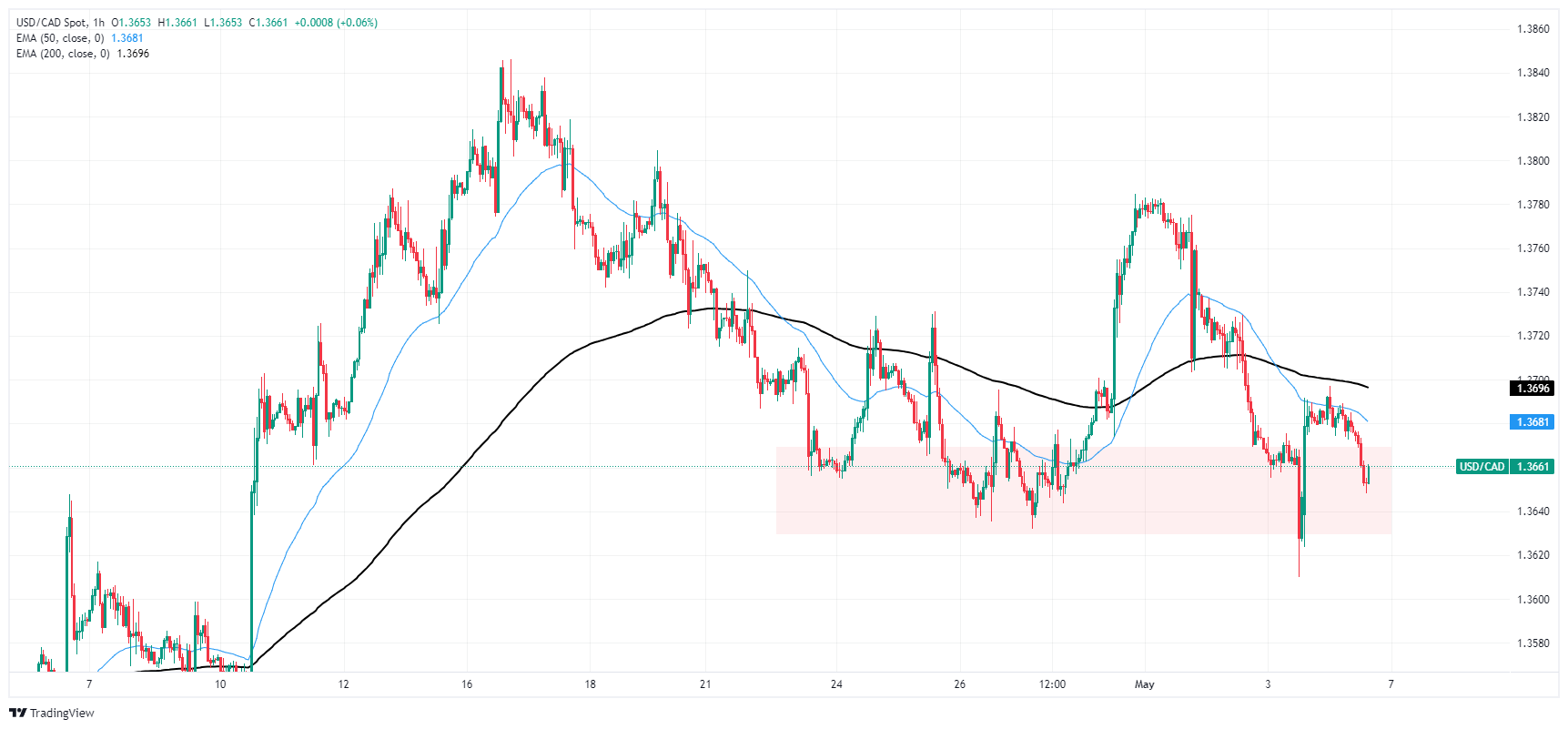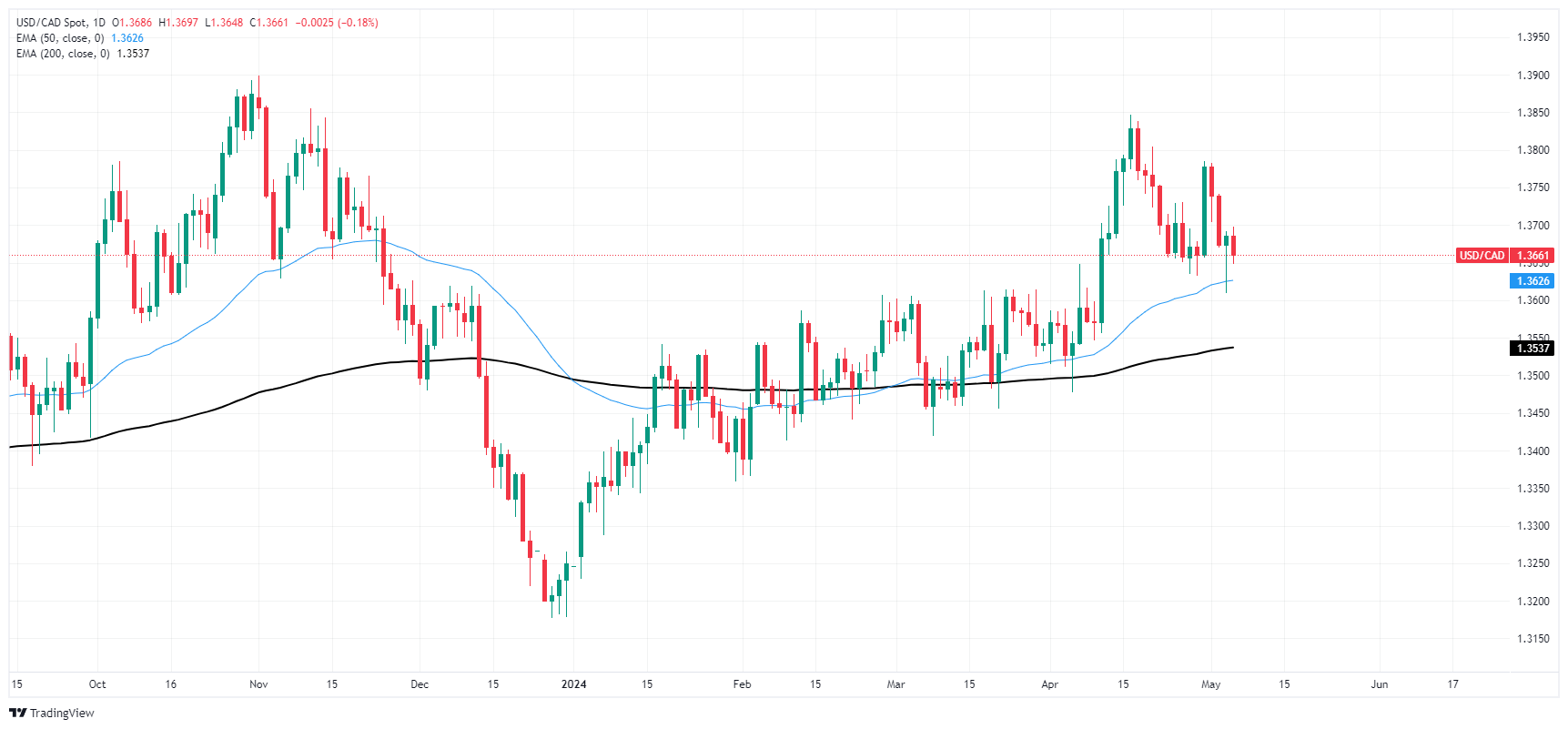- Phân tích
- Tin tức và các công cụ
- Tin tức thị trường
- Canadian Dollar finds room for recovery in quiet Monday action
Canadian Dollar finds room for recovery in quiet Monday action
- Canadian Dollar moves broadly higher in Monday rebound.
- Canada data is thin until Friday’s labor figures.
- Rate markets put odds of September Fed rate cut at 65%.
The Canadian Dollar (CAD) is experiencing a moderate rebound on Monday, recovering ground that was lost late last week during the risk-off plunge as markets pulled away from the CAD. Markets are kicking off the new trading week on the upside, however, with thin Canadian economic data throughout the week until Friday’s labour report.
Canada will deliver this week’s first CAD data on Tuesday with the Ivey Purchasing Managers Index (PMI) for the month of April. Market reaction will be muted at best with the mid-tier data release, and the rest of the week remains thin with strictly low-tier economic data from Canada until Friday’s Canadian Unemployment Rate and wages data for April.
Daily digest market movers: Canadian Dollar finds some bids on quiet Monday start
- Canadian Dollar recovers ground on Monday as CAD rebounds from Friday’s sell-off.
- Tuesday’s Canadian Ivey PMI (seasonally-adjusted) is expected to climb to 58.1 from 57.5, a 12-month high.
- Friday’s Canadian Unemployment Rate is expected to tick upwards in April to 6.2% from 6.1%.
- With little else of meaningful impact on the data docket this week for either CAD or the US Dollar, looking ahead to better data prints and reactions to headlines is all that’s left for markets.
- According to CME’s FedWatch Tool, rate markets are betting around 65% odds of at least a 25-basis-point cut from the Federal Reserve (Fed) in September.
Canadian Dollar price today
The table below shows the percentage change of Canadian Dollar (CAD) against listed major currencies today. Canadian Dollar was the strongest against the Japanese Yen.
| USD | EUR | GBP | CAD | AUD | JPY | NZD | CHF | |
| USD | -0.20% | -0.25% | -0.23% | -0.19% | 0.21% | -0.06% | -0.05% | |
| EUR | 0.19% | -0.05% | -0.04% | -0.01% | 0.39% | 0.13% | 0.14% | |
| GBP | 0.23% | 0.06% | 0.02% | 0.06% | 0.45% | 0.19% | 0.20% | |
| CAD | 0.23% | 0.04% | -0.02% | 0.04% | 0.45% | 0.17% | 0.18% | |
| AUD | 0.19% | 0.01% | -0.06% | -0.04% | 0.40% | 0.13% | 0.15% | |
| JPY | -0.22% | -0.39% | -0.44% | -0.44% | -0.38% | -0.23% | -0.27% | |
| NZD | 0.06% | -0.13% | -0.19% | -0.17% | -0.13% | 0.28% | 0.01% | |
| CHF | 0.07% | -0.14% | -0.20% | -0.18% | -0.16% | 0.29% | -0.01% |
The heat map shows percentage changes of major currencies against each other. The base currency is picked from the left column, while the quote currency is picked from the top row. For example, if you pick the Euro from the left column and move along the horizontal line to the Japanese Yen, the percentage change displayed in the box will represent EUR (base)/JPY (quote).
Technical analysis: Canadian Dollar pushes back, USD/CAD falls into near-term supply zone
The Canadian Dollar (CAD) is broadly higher, gaining ground against nearly all of its major currency peers on Monday. The CAD is up nearly a quarter of a percent against the US Dollar (USD) and has gained around half of a percent against the Japanese Yen (JPY).
USD/CAD has drifted into familiar lows once more, backsliding into a familiar demand zone below 1.3670. The pair is cycling 1.3660 as CAD buying against the US Dollar keeps the pair pinned below the 200-hour Exponential Moving Average (EMA) near 1.3695.
Daily candlesticks leave USD/CAD in slightly more bullish technical shape, trading north of the 200-day EMA at 1.3550. The pair is up 3.1% in 2024 but is still trading on the low side of the YTD peak near 1.3850.
USD/CAD hourly chart
USD/CAD daily chart
Canadian Dollar FAQs
The key factors driving the Canadian Dollar (CAD) are the level of interest rates set by the Bank of Canada (BoC), the price of Oil, Canada’s largest export, the health of its economy, inflation and the Trade Balance, which is the difference between the value of Canada’s exports versus its imports. Other factors include market sentiment – whether investors are taking on more risky assets (risk-on) or seeking safe-havens (risk-off) – with risk-on being CAD-positive. As its largest trading partner, the health of the US economy is also a key factor influencing the Canadian Dollar.
The Bank of Canada (BoC) has a significant influence on the Canadian Dollar by setting the level of interest rates that banks can lend to one another. This influences the level of interest rates for everyone. The main goal of the BoC is to maintain inflation at 1-3% by adjusting interest rates up or down. Relatively higher interest rates tend to be positive for the CAD. The Bank of Canada can also use quantitative easing and tightening to influence credit conditions, with the former CAD-negative and the latter CAD-positive.
The price of Oil is a key factor impacting the value of the Canadian Dollar. Petroleum is Canada’s biggest export, so Oil price tends to have an immediate impact on the CAD value. Generally, if Oil price rises CAD also goes up, as aggregate demand for the currency increases. The opposite is the case if the price of Oil falls. Higher Oil prices also tend to result in a greater likelihood of a positive Trade Balance, which is also supportive of the CAD.
While inflation had always traditionally been thought of as a negative factor for a currency since it lowers the value of money, the opposite has actually been the case in modern times with the relaxation of cross-border capital controls. Higher inflation tends to lead central banks to put up interest rates which attracts more capital inflows from global investors seeking a lucrative place to keep their money. This increases demand for the local currency, which in Canada’s case is the Canadian Dollar.
Macroeconomic data releases gauge the health of the economy and can have an impact on the Canadian Dollar. Indicators such as GDP, Manufacturing and Services PMIs, employment, and consumer sentiment surveys can all influence the direction of the CAD. A strong economy is good for the Canadian Dollar. Not only does it attract more foreign investment but it may encourage the Bank of Canada to put up interest rates, leading to a stronger currency. If economic data is weak, however, the CAD is likely to fall.
© 2000-2024. Bản quyền Teletrade.
Trang web này được quản lý bởi Teletrade D.J. LLC 2351 LLC 2022 (Euro House, Richmond Hill Road, Kingstown, VC0100, St. Vincent and the Grenadines).
Thông tin trên trang web không phải là cơ sở để đưa ra quyết định đầu tư và chỉ được cung cấp cho mục đích làm quen.
Giao dịch trên thị trường tài chính (đặc biệt là giao dịch sử dụng các công cụ biên) mở ra những cơ hội lớn và tạo điều kiện cho các nhà đầu tư sẵn sàng mạo hiểm để thu lợi nhuận, tuy nhiên nó mang trong mình nguy cơ rủi ro khá cao. Chính vì vậy trước khi tiến hành giao dịch cần phải xem xét mọi mặt vấn đề chấp nhận tiến hành giao dịch cụ thể xét theo quan điểm của nguồn lực tài chính sẵn có và mức độ am hiểu thị trường tài chính.
Sử dụng thông tin: sử dụng toàn bộ hay riêng biệt các dữ liệu trên trang web của công ty TeleTrade như một nguồn cung cấp thông tin nhất định. Việc sử dụng tư liệu từ trang web cần kèm theo liên kết đến trang teletrade.vn. Việc tự động thu thập số liệu cũng như thông tin từ trang web TeleTrade đều không được phép.
Xin vui lòng liên hệ với pr@teletrade.global nếu có câu hỏi.















